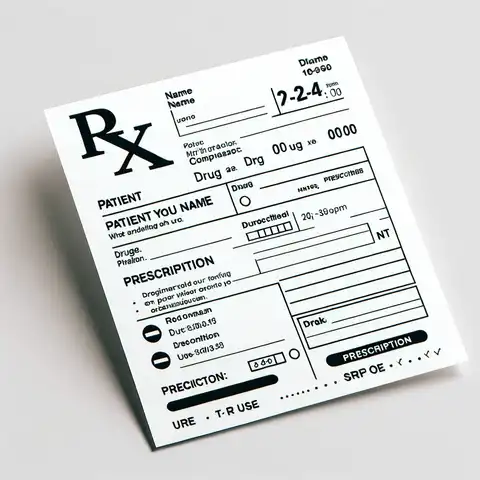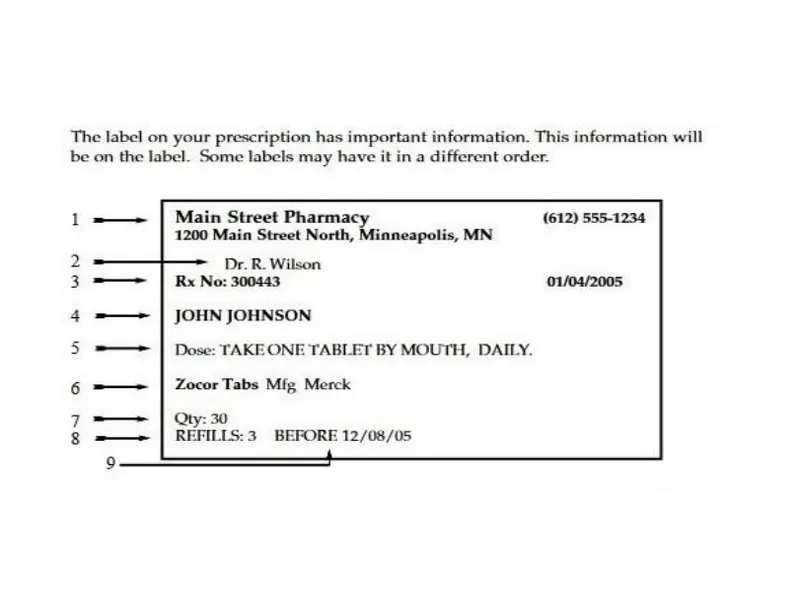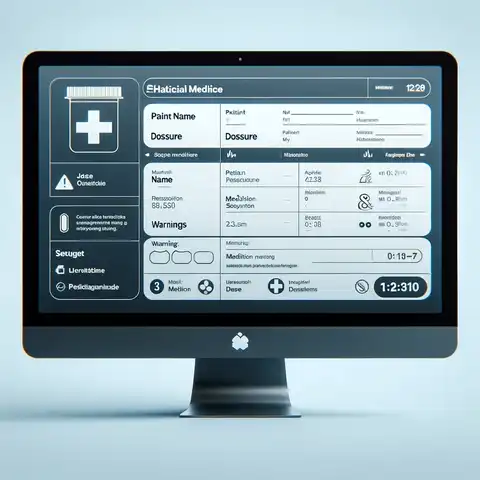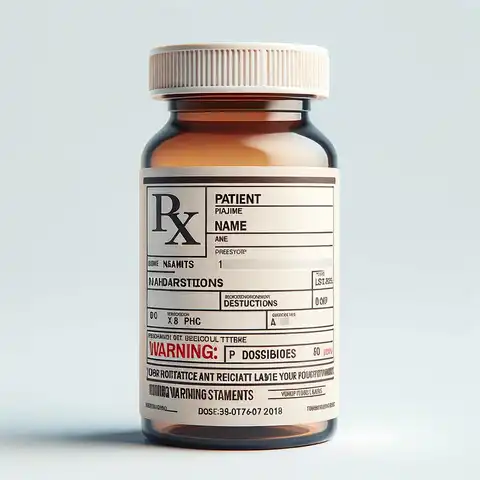5+ Free Prescription Label Template and The Benefits
 label template on a white background, designed for a paper format" width="480" height="480" />
label template on a white background, designed for a paper format" width="480" height="480" />
What Should Be Included in a Prescription Label Template?

The following are some of the fields that might be included in a prescription label template:
- Patient Name: The label must have the name of the person who needs the medicine. This makes sure the right person gets it.
- Prescription Description: This part tells what the medicine is used for.
- Prescription Number: Every medicine has a special number.
- Drug Name: The label shows the name of the drug. It is important to know what you are taking.
- Quantity Prescribed: This tells how many pills or liquids are in the bottle.
- Instructions for Use: This part is very important. It tells how often and how much medicine to take. It also says if you should take it with food or not.
What are the different types of prescription labels?
 label template on a medicine bottle" width="480" height="480" />
label template on a medicine bottle" width="480" height="480" />
The following is a list of different types of prescription labels:
- Prescription Label: This is the most common label. It’s on the medicine bottle or box. It has the patient’s name, the drug name, and how to take it.
- Medication Label: This label gives more details than the basic prescription label.
- Drug Information Sheet: This sheet comes with the medicine. It has lots of information about the drug.
- Patient Medication Information Form: This form is for the patient. It lists all the medicines a person is taking.
- Patient Medication History Record: This record keeps track of all the medicines a person has taken over time. It’s good for seeing what works and what doesn’t.
In the United States, prescription labels have been regulated by the Food and Drug Administration for over 60 years.
Why the FDA Regulates These Labels
- Safety First: The FDA ensures that the information on these labels is right and safe.
- Avoid Mistakes: By checking these labels, the FDA helps stop mistakes.
- Clear Information: The FDA wants to ensure all the information about a medicine is clear and easy to understand.
What are the benefits of using prescription labels?
The following are the benefits of prescription labels:
Prevents Medication Errors
- Clear Instructions: Prescription labels have clear instructions about how to take the medicine.
- Right Dosage: The labels show the right amount of medicine to take. This stops people from taking too little or too much.
- Allergy Alerts: Labels can warn about allergies. If someone is allergic to a medicine, the label will tell them not to take it.
- Side Effects Info: The labels tell about side effects.
Helps Doctors and Pharmacists
- Easy to Track Medicines: Doctors and pharmacists can quickly see what medicines a patient is taking. This helps them give the best care.
- Reduces Confusion: With so many medicines that sound the same, labels help to tell them apart. This stops mix-ups.
Good for Organizing
- Keeps Track of Medicines: Labels help track what medicines are in stock.
- Helps with Refills: The label shows when to get more medicine.
Legal and Professional Standards
- Meets Laws: Prescription labels are needed by law. They make sure the medicine is safe and used correctly.
- Professional Look: Labels make the medicine bottle look official and professional. This shows the medicine is from a real doctor or pharmacy.
Educational for Patients
- Teaches About Medicine: Labels help people learn about their medicine.
- Encourages Questions: If someone needs help understanding the label, they might ask their doctor or pharmacist.
Emergency Information
- Contact Info: If there’s a problem, the label has a phone number to call.
- Medicine Name: Doctors can see what medicine someone takes in an emergency. This helps them give the right help.
What are the disadvantages of using prescription labels?
The disadvantages of using prescription labels are the following:
- They are more detailed than a doctor’s prescription.
- They can mislead patients, who might not know what the label means.
- The label may need more meaningful information about the medicine, such as how often it should be taken.
- They are costly to produce and can’t be customized for each patient.
What are the dangers of not reading prescription labels?
Do you know that a lot of people don’t read prescription labels? This is a bad habit because not reading the prescription labels can lead to many diseases and even death. It is essential to read the label and follow the instructions carefully.
Many people do not read the labels because they think they are just wasting their time or don’t want to get into trouble with their doctor.
We should always be aware of what we are taking. We should also be careful about what we eat and drink while taking medication.
What do you need to know about the DEA number?
A DEA number is a unique identifier for each drug, and the Drug Enforcement Administration uses it to regulate the distribution of drugs.
- The DEA number is a unique identifier for each drug.
- The Drug Enforcement Administration uses it to regulate the distribution of drugs. The DEA number consists of three parts:
- The first letter “A” indicates that it belongs to the DEA;
- The second letter indicates which schedule it belongs to;
- The third letter and numbers indicate its specific identification number.
When Should We Use a Prescription Label?
- Identifying the Medication: The most basic use of a prescription label is to tell you what medicine you have.
- Understanding Dosage Instructions: The label tells you how much medicine to take and how often.
- Being Aware of Side Effects: Labels often list possible side effects.
- Instructions on How to Take the Medication: Some labels say if you should take the medicine with food or on an empty stomach.
- Duration of Medication: The label might tell you how long it takes to keep taking the medicine. This helps ensure you use it enough to improve, but not too much.
- Guidance for Handling Problems: If something goes wrong or you have questions, the label often has advice or a number to call for help.
Why Health Authorities Recommend Prescription Labels
- For Safety: Groups like the FDA and WHO suggest using labels because they keep patients safe. They make sure people use their medicine the right way.
- To Avoid Mistakes: Labels help stop mix-ups with medicines.
- Better Care: Doctors and pharmacists can give better advice and help when they see a clear label.
Who is Required to Fill Out a Prescription Label?
 label template on a white background, designed for a paper format" width="480" height="480" />
label template on a white background, designed for a paper format" width="480" height="480" />
Pharmacists
- Main Responsibility: Pharmacists are usually the ones who fill out prescription labels. They use the doctor’s prescription to get all the details right.
- Accuracy is Key: Pharmacists must be very careful and ensure all the information on the label is correct.
Doctors
- Initial Prescription: Doctors write the prescription. This includes the medicine, dosage, and how to take it. Pharmacists use this to make the label.
- Electronic Prescriptions: Sometimes, doctors send prescriptions electronically directly to the pharmacy. Then, the pharmacist fills out the label.
Healthcare Professionals
- More Than Just Doctors: Nurse practitioners and other health helpers can also say what medicine you need.
- Helping in Hospitals: In big places like hospitals, other health workers might help prepare your medicine label.
Legal Requirements
- Follow the Rules: There are laws about who can fill out prescription labels. These laws are there to make sure patients stay safe.
Special Cases
- Compounded Medicines: The person making the medicine (often a pharmacist) will fill out the label for special medications made just for one person.
- In Research or Trials: Scientists or doctors in charge of a medical study might fill out labels for medicines used.
How To Create Your Prescription Label Template
Creating Your Prescription Label Template: A Step-by-Step Guide
Gather Information
- List What You Need: Before you start, make a list of the information that should be on the label. This includes the drug name, patient name, dosage, and instructions.
Choose a Format
- Paper or Electronic: Decide if you want your template on paper or in an electronic format. Paper can be printed and attached to bottles, while electronic can be filled out on a computer or tablet.
Find a Template Online
- Look for Resources: You can find prescription label templates on many websites. Some are free, and some might cost a little.
- Downloadable Templates: Websites like labeltemplate.net offer templates you can download and customize.
Customize the Template
- Add Your Info: Once you have a template, add the necessary information fields like the patient’s name, prescription number, and dosage instructions.
- Make It Clear and Readable: Use a clear font and make sure the text is big enough to read easily.
Include Legal Requirements
- Check the Rules: Make sure your label meets any legal requirements. This might include specific warnings or instructions that have to be on the label.
Add Safety Information
- Side Effects and Warnings: Include a section for side effects and any warnings about the medication. This is important for safety.
Review and Test Your Template
- Double-Check: Review your template to ensure everything is correct and easy to understand.
- Test It Out: Try filling out your template with sample information to see if it works well.
Use in Practice
- Ready to Go: Once you’re happy with your template, you can use it for real prescriptions.
Update as Needed
- Keep It Current: If anything changes, like new legal requirements, update your template.
How long does it take to get a prescription label?
The time it takes to get a prescription label varies from one pharmacy to another, and it can take as little as five minutes or as much as 45 minutes.
The time it takes to get a prescription label depends on the type of medication and how busy the pharmacy is at that moment. The pharmacist must check the patient’s ID and prescription history in their system, taking some time.

 label template on a white background, designed for a paper format" width="480" height="480" />
label template on a white background, designed for a paper format" width="480" height="480" />
 label template on a white background, designed for a paper format" width="480" height="480" />
label template on a white background, designed for a paper format" width="480" height="480" />

 label template on a medicine bottle" width="480" height="480" />
label template on a medicine bottle" width="480" height="480" /> label template on a white background, designed for a paper format" width="480" height="480" />
label template on a white background, designed for a paper format" width="480" height="480" />